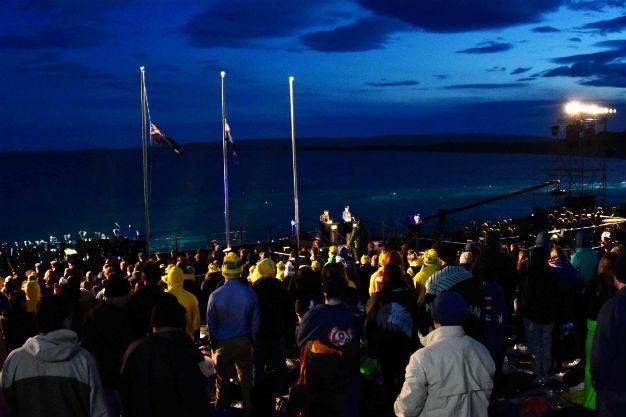Australians, New Zealanders commemorate fallen soldiers of Gallipoli at dawn service
ÇANAKKALE – Doğan News Agency

DHA photo
Around 2,000 Australians and New Zealanders commemorated the fallen soldiers on the Gallipoli peninsula in the western province of Çanakkale on early April 25 with a dawn service, marking the 101st anniversary of the landing of Allied troops during World War I.
The commemorations before the dawn service began with a music recital by the military band of New Zealand and Australia. Documentaries and soldiers’ interviews during the times of war were screened as the Australian and New Zealand Army Corps (Anzac) waited for the service throughout the night.
The dawn service began at 5:30 a.m. with the arrival of honor guards. The Anzacs stood for a minute of silence for their fallen soldiers, as well as the fallen Turkish soldiers.
Çanakkale deputy governor Bekir Sıtkı Dağ, New Zealand Defense Minister Gerry Brownlee and Australia Veterans’ Affairs Minister Dan Tehan attended the dawn service along with other military and civil officials.
“It is a story of brave men who fought in a foreign land for our values, our freedoms and our sovereignty,” Tehan said while delivering the first speech of the ceremony.
“It is a story of courage, resilience and a unique Anzac spirit of rolling your sleeves up and getting the job done, no matter what the adversity,” he added.
Tehan noted more than 11,000 Australians and New Zealanders died in the eight-month-long Gallipoli campaign.
Brownlee also noted the Anzacs’ “resilience and humanity in the face of hardship remain fundamental to New Zealanders’ sense of nationhood to this day.”
“Today we are proud to stand yet again alongside our Australian cousins, with whom we share the enduring Anzac bond,” Brownlee said.
In addition, the famous letter penned by the founder of the Republic of Turkey, Mustafa Kemal Atatürk, in 1934 to Anzac mothers who lost their sons in the campaign was also read out, both in Turkish and English.
“Those heroes that shed their blood and lost their lives, you are now lying in the soil of a friendly country, therefore rest in peace. There is no difference between the Johnnies and Mehmets to us, where they lie side by side here in this country of ours. You, the mothers, who sent their sons from far away countries, wipe away your tears. Your sons are now lying in our bosom and are in peace. After having lost their lives on this land, they have become our sons as well,” the letter read.
A commemoration prayer was later held as Anzacs shed tears during the dawn service. The service ended by raising the countries’ flags and a performance of their national anthems as wreaths were laid on a pedestal.
Gallipoli was the first time that soldiers from Australia and New Zealand fought under their own flags and is seared in the national consciousness as a point where their nations came of age, emerging from the shadow of the British Empire.
The Gallipoli campaign has resonated through generations, which have mourned the thousands of soldiers from the Anzacs who were cut down by machinegun and artillery fire as they struggled ashore on a narrow beach.
The fighting would eventually claim more than 130,000 lives, 87,000 of them on the side of the Ottoman Turks, who were allied with imperial Germany in World War I.
The Allied forces also included British, Irish, French, Indians, Gurkhas and Canadians. Approximately 58,000 Allied soldiers died, roughly half of them from Britain and Ireland, according to the Gallipoli Association.
Only 11,000 have known graves on the Gallipoli peninsula. Others simply have their names inscribed on memorials.
The peninsula has become a site of pilgrimage for visitors from Australia and New Zealand in particular, who honor their fallen in graveyards halfway around the world on Anzac Day each year.
Last year’s ceremony marked the centennial of the campaign and saw the attendance of more than 10,000 people.
